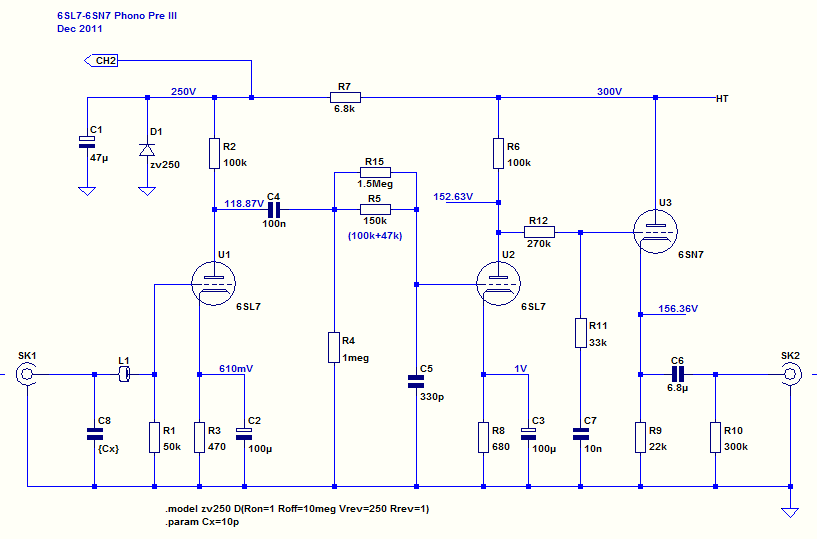Phono Preamplifier #2 Latest Modifications
Last Modified: 21 Jul 2012
Compiled from Audio Talk forum topic
E
arly 2011 I got involved in a short e-mail correspondence with a chap in Canada, he asked is the circuit and info on my web page for a slightly modified Danielak phono pre-amp up to date, I replied yes it is, and then I thought actually I'd better double-check, and found actually not quite, what I'm using is a bit different, so I told him that, and in what way(s) ...
For reference, Bob Danielak's original pre-amp is here: https://www.abcelectronique.com/annuaire/montages/cache/1009/preampli-phono.html
I applied sort of mods as per Jeremy Epstein, then quickly dumped the cathode battery idea, mainly 'cause of the sonic properties of modern rechargeable batteries rather than the idea. To (try) get more gain out of it I effectively doubled the anode resistor value of the 2nd stage and cap bypassed the cathodes. I thought it was the best phono pre I'd ever made and I e-mailed Bob to tell him so. I think he was pleased. (See Phono Preamplifier #1).
Conversation with the Canadian chap continued, as he was looking for more gain, and could it be done simpler, e.g. is it absolutely necessary to have paralleled triodes for the 1st stage. Danielak's DC coupled pre-amp came up (the Canadian chap found it) but apparently this has not gone down well on the DiyAudio forum.
So I started looking at my one again, and eventually figured out that if one of the 6SL7's was moved to 2nd stage, we'd get something approaching more like CD player output level, which it does. Not only that, but one less double-triode required to boot. Which suited the Canadian fellah I think as space available for valve sockets was at a premium apparently.
Also, the Miller capacitance of the input stage is reduced by half, which, it turns out, plus allowing for the arm rewiring (see Rega Arm Rewire), suits my Nagoaka MP10 cartridge better than hitherto actually. Anyway so it all works just fine thank you. Another pinnacle of excellence reached...

Photos follow then circuit.
Note #1 ~ second octal socket from the front has become "not used".
Note #2 ~ it uses Panasonic 'FC' electrolytics for the cathode bypass, as was recommended by Nick Gorham.
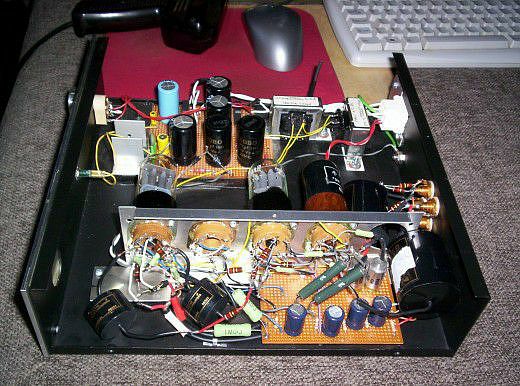
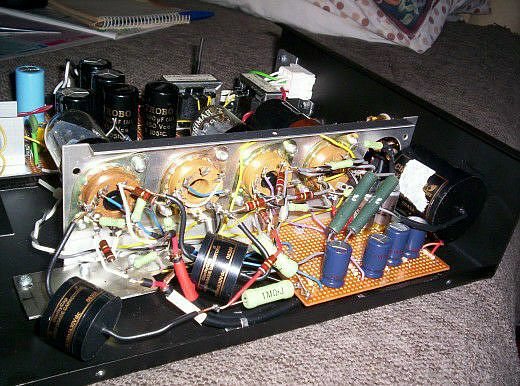
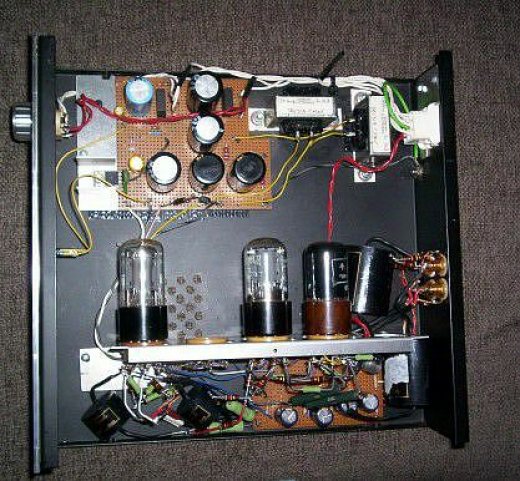
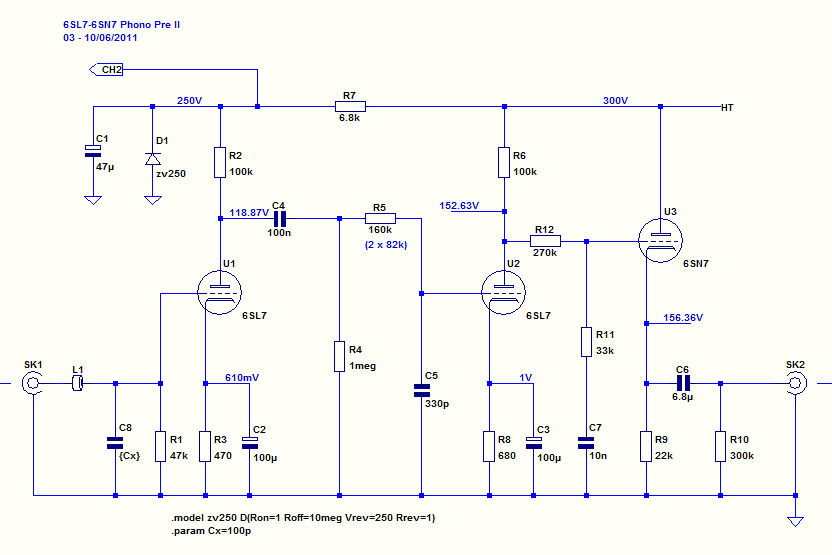
'{Cx}' is any extra capacitance for cartridge matching. In my case this was not needed, as the total input capacitance is: Miller effect, approx. 150pF, plus strays, cables etc.
Components list:
R1, 2, 11, 12 = Kiwame 2W carbon film
R3, 7, 8 = any
R4 = Kiwame 5W carbon film
R5, 6, 10 = Arcol 0.5W carbon composite
R9 = Welwyn/Vishay 9W vitreous enamelled wirewound
C1 = 450V electrolytic (low ESR preferred)
C2, 3 = Panasonic FC 100V low ESR electrolytic radial
C4, 6 = ICW 'ClarityCap' audio-grade polyproplylene, 630V
C5 = LCR 160V polystyrene
C7 = LCR 630V polystyrene
U1, 2 = NOS Brimar
U3 = NOS ex-military (CV1988)
L1 = ferrite bead
R3, 7, 8 = any
R4 = Kiwame 5W carbon film
R5, 6, 10 = Arcol 0.5W carbon composite
R9 = Welwyn/Vishay 9W vitreous enamelled wirewound
C1 = 450V electrolytic (low ESR preferred)
C2, 3 = Panasonic FC 100V low ESR electrolytic radial
C4, 6 = ICW 'ClarityCap' audio-grade polyproplylene, 630V
C5 = LCR 160V polystyrene
C7 = LCR 630V polystyrene
U1, 2 = NOS Brimar
U3 = NOS ex-military (CV1988)
L1 = ferrite bead
Power supply
Is as per phono preamplifier #1, except the CLCLC filter was simplified to CLC, 100 µF, 15H, 200 µF by virtue of the last choke being bypassed (omitted) and the last two 100 µF caps combined in parallel. The primary reason for this was to obviate power supply resonances due to the equal values caps and chokes forming a resonant tuned circuit.
Again the filament supply is 12.6VDC regulated, simply by a TIP120 Darlington basically biased from a 13V Zener. There is a 2.5Ω inrush limiter (power thermistor) on the output side of the TIP120 to give it an easier time on initial start-up.
I then had a bit of bother because since the original set-up was 2 x 6SL7 & 2 x 6SN7, the heaters of each pair could be in series, total 900 mA. But one 6SN7 was taken out, so what to do?

A 22Ω resistor in series with the remaining 6SN7 filament wasn't going to work, as the filament wouldn't go past 3V.
Ah yeah but no but
 it just so happens that there is 6.3VAC coming up the umbilical from the transformer box, but hitherto never used.
it just so happens that there is 6.3VAC coming up the umbilical from the transformer box, but hitherto never used. So it was simply a case of adding a twisted pair of wires and pins to the two spare chassis socket positions and voila. It do am worketh....
Appendix – December 2011
Been playing with this a bit more ~ further to the RB250 arm rewiring and getting the tracking weight more exactly right (electronic scales) ~ (this is all on a Thorens TD160).
It's come on very nicely but there's still summat not quite there. But ~ ~ I am reminded again about this "issue" I currently have at the moment about resistors in series with the signal, and what they do to the signal, so I'm recognising that kind of effect here. And, of course, the RC EQ sections include resistors in series ~ with big values!
~ I am reminded again about this "issue" I currently have at the moment about resistors in series with the signal, and what they do to the signal, so I'm recognising that kind of effect here. And, of course, the RC EQ sections include resistors in series ~ with big values!
Turns out I'd already reduced R5 from 160k to 150k, so could it go down any further? To make the treble end less dull. Had a go but actually those two particular resistors (100k + 47k in series) seem to sound the best anyway (unless I'm imagining it), so another option is a shunt.
So, shunted it with a glazed metal film 1.5M (making it 136k total), and, that seems to be the wasp's ankles.
Then played a bunch of stuff to try it out and on the whole it's all rather fantastic. Badly engineered recordings really trip up though ~ I whanged on the last disc of a Madonna best-of, which to date I'd always thought was rather good, jeez what an awful mess. Vastly over-bloated bass and compression up to the eye-balls. This makes the treble very poor, and it shouldn't be. It's in there somewhere, just can't get out....
OK then, as another experiment try Led Zeppelin IV, which I usually avoid cos it "sounds rough". This disc I got off Mr. Branson soon after he'd started his Virgin records by mail order business, problee still working out of his bedroom at his parents' place soon after leaving school, that's how long ago I bought it!
OK so, it turns out that the "rough" aspect is actually lots and lots (and lots!) of jangly electric guitar strings, but I problee never been able to hear all that properly before! Really quite impressed with this record now TBH ~ quite subdued in the bass dep.t still, but that's probably just as well!
Also, following what someone had mentioned to me about processed vocals, ol' Robert Plant's syllables are perfectly clear 90% of the time, despite him being quite set back into the background and with some echo on ~ why do they do that? Not so much when he's doing high-pitched screaming bits though.
So I'm well chuffed with that.
It's come on very nicely but there's still summat not quite there. But ~
 ~ I am reminded again about this "issue" I currently have at the moment about resistors in series with the signal, and what they do to the signal, so I'm recognising that kind of effect here. And, of course, the RC EQ sections include resistors in series ~ with big values!
~ I am reminded again about this "issue" I currently have at the moment about resistors in series with the signal, and what they do to the signal, so I'm recognising that kind of effect here. And, of course, the RC EQ sections include resistors in series ~ with big values! Turns out I'd already reduced R5 from 160k to 150k, so could it go down any further? To make the treble end less dull. Had a go but actually those two particular resistors (100k + 47k in series) seem to sound the best anyway (unless I'm imagining it), so another option is a shunt.
So, shunted it with a glazed metal film 1.5M (making it 136k total), and, that seems to be the wasp's ankles.
Then played a bunch of stuff to try it out and on the whole it's all rather fantastic. Badly engineered recordings really trip up though ~ I whanged on the last disc of a Madonna best-of, which to date I'd always thought was rather good, jeez what an awful mess. Vastly over-bloated bass and compression up to the eye-balls. This makes the treble very poor, and it shouldn't be. It's in there somewhere, just can't get out....
OK then, as another experiment try Led Zeppelin IV, which I usually avoid cos it "sounds rough". This disc I got off Mr. Branson soon after he'd started his Virgin records by mail order business, problee still working out of his bedroom at his parents' place soon after leaving school, that's how long ago I bought it!
OK so, it turns out that the "rough" aspect is actually lots and lots (and lots!) of jangly electric guitar strings, but I problee never been able to hear all that properly before! Really quite impressed with this record now TBH ~ quite subdued in the bass dep.t still, but that's probably just as well!
Also, following what someone had mentioned to me about processed vocals, ol' Robert Plant's syllables are perfectly clear 90% of the time, despite him being quite set back into the background and with some echo on ~ why do they do that? Not so much when he's doing high-pitched screaming bits though.

So I'm well chuffed with that.

Final schematic:
